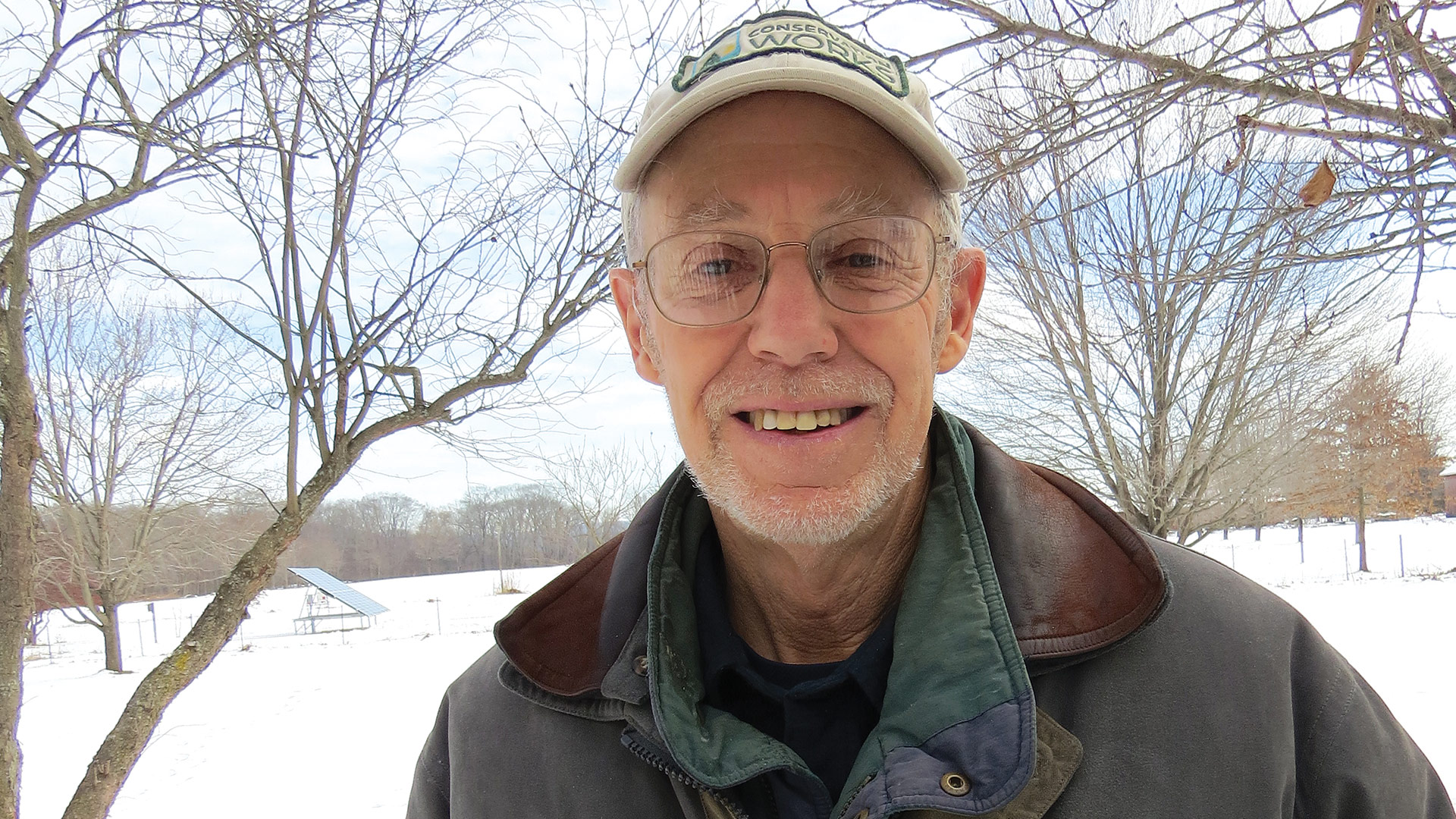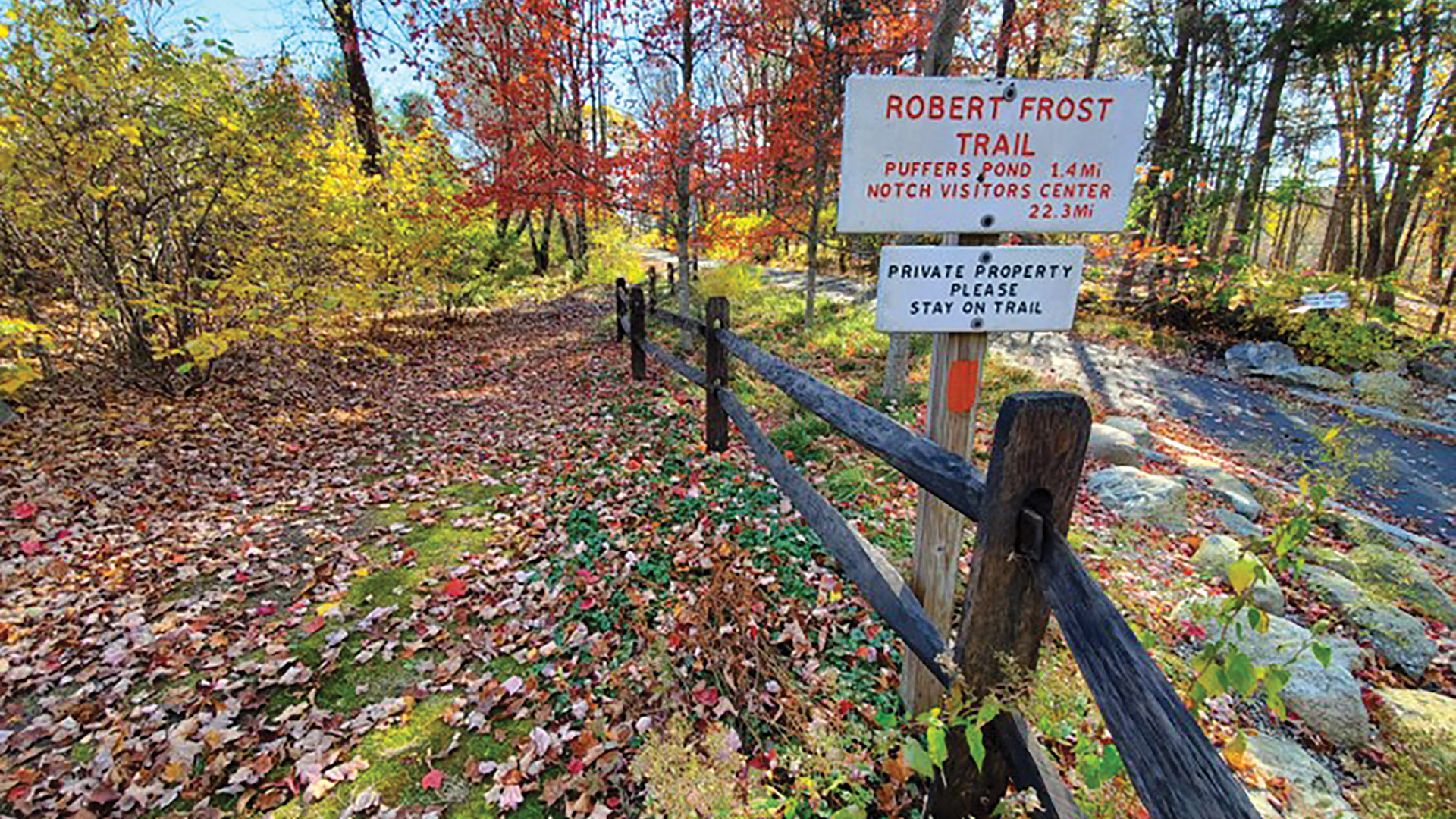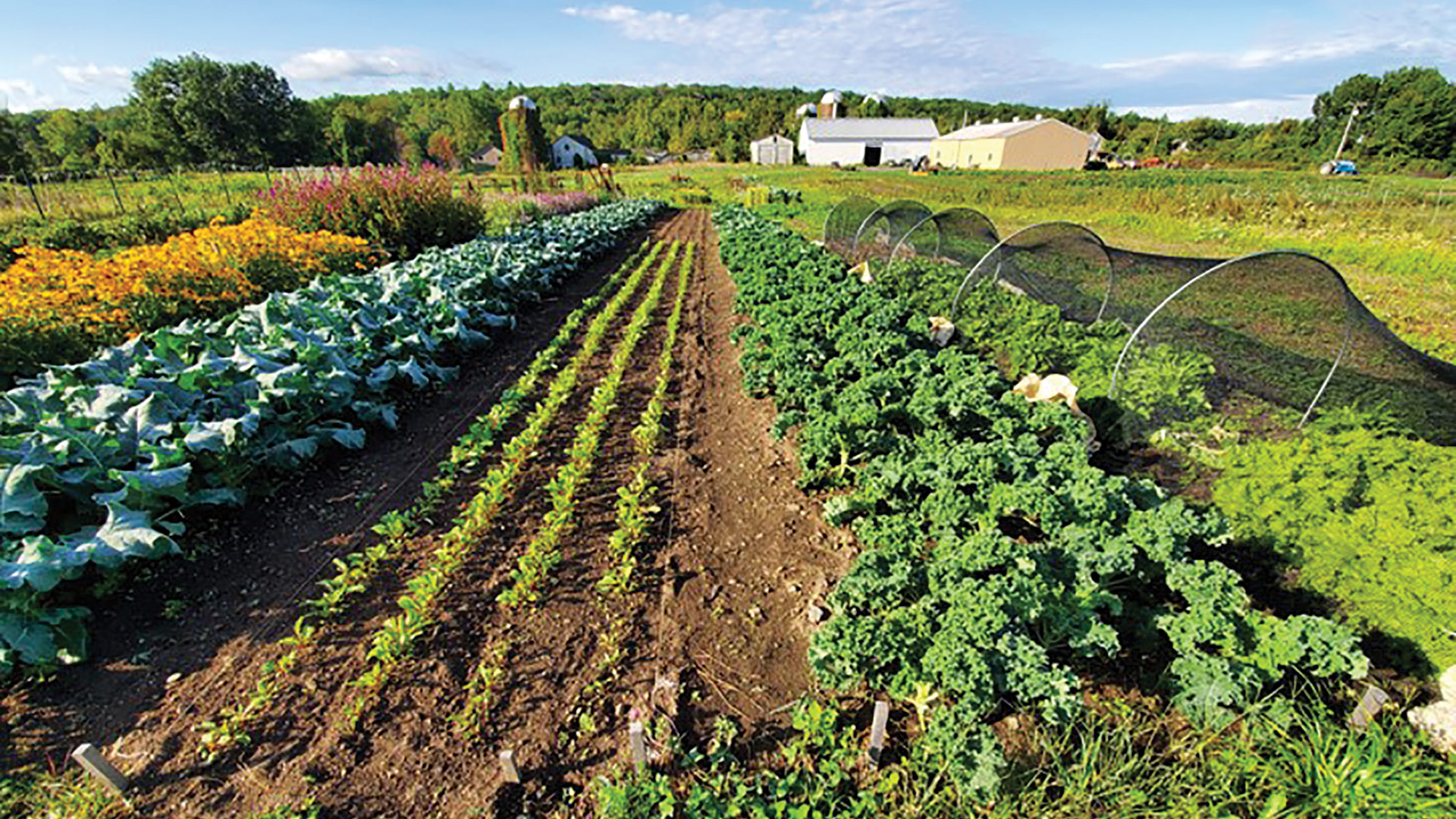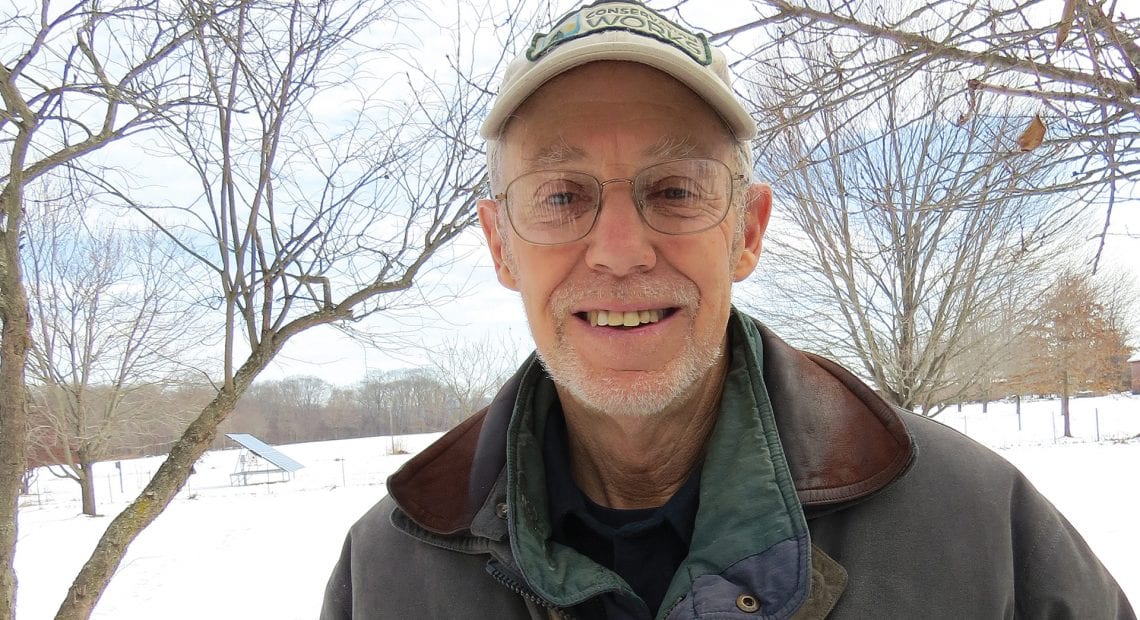To Preserve and Protect

Pete Westover
For more than 30 years, Pete Westover served as Amherst’s conservation director and watershed forester, and over that time he worked with a host of others to preserve large tracts of farmland, create a system of conservation lands, and build roughly 80 miles of trails. In 2006, he left that post to, in essence, partner with others and take his conservation work to a higher, broader plane. The company is called Conservation Works, and it is changing the landscape — or not changing it, as the case may be — in a number of meaningful ways.
The red Prius (what else would he drive?) in Pete Westover’s driveway is not yet five years old.
But he has more than 165,000 miles on it already, by his estimates — he hasn’t looked at the odometer lately — and the number climbs steadily each week.
That’s because he’s on the road — a lot — in his work, and sometimes off the road as well. Indeed, from his home in South Deerfield, he’s packed up and trekked off to dozens of communities in the Commonwealth and beyond, doing work that, well, doesn’t seem much like work.
It’s more of a passion.
And it’s the same for all the partners at a unique company called Conservation Works, a name that doesn’t say it all, necessarily, but goes a long way to explaining what this is.
As it notes on its website, this company works with public, private, and nonprofit landowners to enhance land conservation and ecological resiliency. And it does so through work on everything from conservation of open space and farmland to the development and maintenance of trails; from invasive-plant-management plans to an upcoming workshop on climate-change resilience at Frontier Regional High School in South Deerfield.
“We focus on land — trails, ecology, and land-protection work,” said Westover, the company’s managing partner, who was appointed Amherst’s conservation director and watershed forester in 1974 — the first such position in the state as far as he knows — and held that position for 30 years.
In 2006, he collaborated with Terry Blunt, former executive director of the Connecticut River Watershed Council (now the Connecticut River Conservancy) to create Conservation Works.
Blunt passed away in 2010, but a team of professionals (more on this group later) carries on his work and his legacy.
A look at the portfolio of recent and current projects provides an effective snapshot of both what this company does and the challenges facing municipalities and individual landowners today:
• Providing assistance to the town of Dover for an open space and recreation plan;
• Working with the Massachusetts Department of Fish and Game’s Natural Heritage & Endangered Species office on inventories of rare plants and invasive species on Mount Tom;
• Working with the town of Deerfield on phases I-IV of a municipal vulnerability (climate change) preparedness plan;
• Working with Amherst College on a host of initiatives, from replacement of nine red pine stands to invasive plant monitoring and control;
• Working with Fish & Game on breeding bird surveys in Southwick, Montague Plains, and other communities;
• Providing assistance to the Hilltown CDC on a farmers’ market and local food-promotion program;
• Conducting a wetlands assessment and planning project for the Orchards Golf Club in South Hadley; and
• Working with Lathrop Retirement Community in Northampton to improve trail accessibility at its facility.
And then, there are the projects involving trails and trail systems. The company has worked on dozens of them, from the Three Bridges Trail in Hatfield to the Willard Wood Trail in Lexington to the Robert Frost Trail, which winds its way through several communities in Western Mass.

Conservation Works will be working with the Kestrel Land Trust to overhaul the entire 47-mile Robert Frost Trail, which stretches from the Holyoke Range to Wendell State Forest. (Photo courtesy of Conservation Works)
But, as Westover noted, much of the company’s time and energy is spent on helping communities and individuals preserve land, especially the dwindling amounts of farmland in the Commonwealth.
“We just can’t afford to lose any more farmland,” he said, noting that the state’s Agricultural Preservation Restriction (APR) program has protected more than 80,000 acres to date — roughly a quarter to a third of “what needs to be protected.” Conservation Works has played a role in several efforts to preserve farmland, and has become a valuable partner in navigating what can be a daunting process.
When asked about what’s in the business plan for Conservation Works, which he described a low-overhead company — everyone works out of their homes (when they’re not working in the field) — Westover implied that the goal is to be able to do more of the above, as in all of the above.
For this issue, BusinessWest talked at length with Westover about Conservation Works, the many types of work it undertakes, the importance of conversation, and even the already-visible signs of climate change. While doing so, that passion mentioned earlier is clearly evident.
No Walk in the Park
When Westover talks about an MVP, he isn’t referring to most valuable player in the NFL or NBA.
In his world, that acronym stands for municipal vulnerability plan, like the one Conservation Works is finalizing for Deerfield. Such a plan involves climate change and what such developments as rising temperatures and rising rivers — which are both already happening — mean for communities.
No community had an MVP until a few years ago, and most still don’t have one now, but the number of cities and towns looking into getting something down on paper is growing, said Westover, because more municipal leaders are coming to understand that climate change is real.

Conservation Works has partnered with the New England Small Farm Institute on a long-term land-preservation plan for the 420-acre Lampson Brook Farm in Belchertown, one of many initiatives to preserve dwindling farmland in the region. (Photo courtesy of Conservation Works)
And Deerfield’s plan, now in the latter stages of development, could become a regional and even a national model.
“It’s state-funded,” he told BusinessWest, “and the state’s been putting a lot of money into not only phase one — which is an analysis of what the vulnerabilities are in each town with such things as flooding and agriculture damage from temperature changes, and damage to town facilities — but also with follow-up programs that give money for actual improvements.
“Every town is now expected to come up some kind of municipal vulnerability plan in response to climate change,” he went on, noting that he’s now talking with officials in Bernardston about such a plan, and he expects others to follow suit.
Thus, MVP becomes part of the alphabet soup of acronyms one finds in this realm — from DFG (Department of Fish & Game) to MDAR (Mass. Department of Agricultural Resources) to FCROG (Franklin Regional Council of Governments) — that the partners at Conservation Works will use as they go about their work.
And, as Westover noted, it’s a talented team with members who bring specific areas of expertise to the various projects on the to-do pile. That team also includes:
• Fred Morrison, who brings expertise in everything from geology to freshwater mussels to dragonflies;
• Laurie Sanders, a naturalist, writer, and former host and producer of Field Notes, a weekly natural history series that aired on NEPR;
• Christopher Curtis, retired chief planner and section manager for the Land Use and Environmental Section of the Pioneer Valley Planning Commission, a consulting environmental planner for the company;
• Dick O’Brien, former regional director for the Trustees of the Reservations and director of the Buck Hill Conservation Education Center, who brings to the table extensive experience as a conservation land manager and specialist in the design and construction of sustainable and ADA-accessible trails; and
• Molly Hale, who worked for 10 years as an independent contractor and owner of Molly Hale Wildlife Biologist before joining the company in 2010. She has completed detailed habitat assessments and surveys for rare plants and animals on more than 3,000 acres.
Together, the partners are working on more than a dozen projects at any given time, said Westover, adding that there is a consistent pipeline of work.
And, as noted, much of that work involves land preservation, an often time-consuming and difficult process with a number of steps, beginning with a landowner willing to seek restrictions on his or her property. The company has created a strong niche helping landowners work with the Massachusetts Department of Agricultural Resources to complete Agricultural Preservation Restriction (APR) applications, assemble supporting materials, obtain funding assistance, and make the case for approval to local town boards and committees and the state Agricultural Lands Preservation Committee.
Such work, and the company has undertaken a lot of it, takes on a heightened sense of urgency as the challenges for farmers mount and the value of real estate — especially in the eastern part of the state — continues to rise.
“We’re losing a lot of dairy farms; 20 years ago, we had something like 650 dairy farms, and now we’re down to under 200,” Westover said. “And our orchards are under pressure. Land is in extreme demand here in the Valley, so if land is available, people are going to bid on it.”
Since the APR program began roughly 40 years ago, more than 30,000 acres have been preserved in Hampshire County alone, said Westover, adding that there have been some recent success stories, including a project he worked on — the Szala Farm in Hadley.
“We had been concerned about that property because the owners had been approached by developers regularly,” he said. “Fortunately, that won’t become a subdivision.”
Growing Pains
But more subdivisions are needed, he said, adding that there must be a balance between preservation efforts and needed new commercial and residential development.
“Land preservation has to go in parallel with land development,” he explained. “We’re not trying to protect everything; we’re trying to create a balance. In Amherst, for example, the balance is pretty good; there’s a lot of protected farmland, a lot of open space, but there has been a lot of development as well.”

Conservation Works built a 450-foot boardwalk in Norcross Wildlife Sanctuary in Wales, one of hundreds of projects in its portfolio. (Photo courtesy of Conservation Works)
Helping communities create such a balance through open-space plans, trail creation, and other initiatives is a big part of the portfolio of services offered by Conservation Works, which has many types of clients. These include municipaliti; private companies and institutions, like the Orchards Golf Club, Lathrop Communities, and Amherst College; and a host of land-conservation trusts.
These include the Amherst-based Kestrel Land Trust, perhaps the company’s biggest client. Indeed, Conservation Works is now assisting Kestrel with a number of initiatives, including wood turtle habitat monitoring in Agawam, work on the Robert Frost Trail, construction of the Holland Glen Trail in Belchertown, and land negotiations in collaboration with the Silvio O. Conte National Wildlife Refuge.
Trail work has become a big part of the portfolio, with work in communities across the state, from Newton to Westfield (Stanley Park) to Fitchburg.
“One of our hopes with trail development is that everyone will have, within walking distance, a trail they can use, whether it’s a 10-minute walk or a 20-minute walk,” Westover noted, adding that the company is working on a trails project in Southampton and continues to assist Lathrop Communities with trail development on its properties.
One of the better success stories in this broad realm is the Robert Frost Trail, which now stretches 47 miles and runs from the Holyoke Range to the Wendell State Forest.
“It goes through a lot of public lands, town-conservation lands, state forests, and state Fish & Game land, but it also goes through a lot of private land, by permission,” noted Westover, who helped conceive the initiative decades ago. “It’s a wonderful asset, a real recreational resource, and we worked with the Kestrel Land Trust to completely overhaul the trail because maintenance tends to fall behind; we’re going to go in and replace bridging, get rid of downed trees, replace signage, and more.”
Meanwhile, a growing amount of work falls into the category of invasive-species inventory and subsequent action to control those species, he said, adding that some of these problems are directly linked to climate change.
As an example, he cited frangula alnus, commonly known as glossy buckthorn, a tall, deciduous shrub native to Europe and parts of Africa and Asia.
“It expands exponentially once it comes into an area, and it’s one of about a good half-dozen invasive plants that have absolutely taken over the landscape,” he explained, noting that many of these plants were brought in as landscaping elements and then quickly spread well beyond their intended perimeter.
Forest Park in Springfield is one area that is being threatened by these plants, he said, adding that it is urging the Parks Department to consider some type of action, but there are many others as well.
“I was in Westport, Mass on a project recently,” he recalled. “The multiflora rose down there is so bad you literally cannot walk through the woods. It’s super aggressive — it will take over the landscape, and it’s very hard to get rid of, and that’s true of bittersweet, swallowwort, and many others.
As for climate change, there is plenty of evidence that it is already impacting communities in Western Mass., he said, citing, as just one example, the severity of floods on the Deerfield River.
“The Deerfield has gotten hammered; the farms along the river have been really hit hard by silt that washes up over the farms and smothers the plant growth,” he explained. “Historically, it has always flooded, but the flooding is getting worse, and they’re expected to be even more so.”
Meanwhile, temperature records continue to be set, there are other extreme weather events, and invasive plants, which benefit from hotter, wetter weather, have gained a foothold, which is why communities need an MVP.
Looking ahead, the company, as noted, is looking to expand. Westover and other team members meet periodically with officials at the Massachusetts Small Business Development Center Network for advice on to take the venture to the next level.
“What we’re hoping to do is broaden the number of projects that involve our whole team,” he said, adding that, in addition to larger-scale initiatives, he would, of course, like to expand the portfolio of clients, especially with the region’s colleges and universities, and also entities specializing in land development.
“We’re pretty busy dealing with what’s right in front of us,” he said, noting that he’s working on perhaps 15 projects at the moment. “But we have one eye on the future, and we see opportunities to grow.”
On the Right Trail
That other eye is on everything from migrating birds in the Southwick Wildlife Management Area to needed work on the Robert Frost Trail, to that dreaded glossy buckthorn taking over the region.
It’s a job that takes him all over New England and even beyond and puts hundreds of miles on that red Prius each and every week.
But for Westover and his partners at Conservation Works, it’s only work in the sense that they get paid to do it.
It’s really a passion, and one that is helping to change the landscape in this area — or not change it, as is very often the case — in very positive ways.
George O’Brien can be reached at [email protected]





